1. Overview
Vladimir Guerrero Alvino (born February 9, 1975), often known by his nickname "Vlad the Impaler", is a Dominican former professional baseball player who played 16 seasons in Major League Baseball (MLB) as a right fielder and designated hitter. He played for the Montreal Expos (1996-2003), Anaheim Angels / Los Angeles Angels of Anaheim (2004-2009), Texas Rangers (2010), and Baltimore Orioles (2011).
Guerrero was a nine-time All-Star and was widely recognized for his impressive offensive production, regularly hitting for power and average, as well as his defensive range and strong throwing arm. In 2004, he was voted the American League (AL) Most Valuable Player (MVP). He helped lead the Angels to five AL West championships between 2004 and 2009 and was voted one of the most feared hitters in baseball in a 2008 poll of all 30 major league managers. Regarded as the game's premier "bad-ball hitter", Guerrero consistently hit pitches thrown well outside the strike zone. His aggressive batting style led him to hit more than 30 home runs (HR) in eight seasons and surpass 100 runs batted in (RBI) ten times.
On September 26, 2011, Guerrero surpassed Julio Franco as the all-time MLB leader for hits by a Dominican player, a record later broken by Adrián Beltré in 2014. In 2018, Guerrero was inducted into the National Baseball Hall of Fame, becoming the first position player born in the Dominican Republic to achieve this honor. In 2021, Guerrero and his son, Vladimir Guerrero Jr., became the second father-son duo in MLB history to each have a 40-home run season in their careers, joining Cecil and Prince Fielder. His career batting average of .318 is the highest of any player who primarily played in the 21st century.
2. Early Life and Background
Vladimir Guerrero's early life in the Dominican Republic was marked by humble beginnings and a strong family connection to baseball, which laid the foundation for his future career.
2.1. Early Life and Family
Guerrero was raised in Don Gregorio, Dominican Republic, in a house constructed of mud and brick with a palm-leaf roof. His mother, Altagracia, supported the family by selling street food until Hurricane David devastated the country in 1979. Following the hurricane, his mother frequently traveled between the Dominican Republic and Venezuela to find work, leaving Guerrero and his eight siblings in the care of a great aunt.
Guerrero is the younger brother of former major leaguer Wilton Guerrero, with whom he played for several seasons on the Montreal Expos. His other brothers, Eleazar and Julio Cesar, also played in the farm systems of the Boston Red Sox and Los Angeles Dodgers, respectively. Guerrero is also a cousin to minor leaguers Armando Guerrero and Cristian Guerrero, and the uncle of major leaguer Gabriel Guerrero.
2.2. Introduction to Baseball
From a young age, Guerrero and his brothers played baseball using makeshift equipment. They fashioned gloves from milk cartons and used socks filled with plastic bags as baseballs. Guerrero did not own a real baseball glove until he was 15 years old, when he received one from his older brother, who was already a minor league player.
2.3. Signing Process
As a teenager, Guerrero participated in a tryout for the Dodgers at their baseball complex in the Dominican Republic. However, after eight months, he was sent home without a contract. He also tried out for the Texas Rangers, but was again unsuccessful. In 1993, scout Arturo DeFreites was impressed by Guerrero's strong throwing arm and speed, convincing the Montreal Expos to sign him for 2.10 K USD on March 1, 1993. During the signing process, Guerrero misrepresented his age, claiming to have been born on February 9, 1976. It was not until March 2009 that he inadvertently revealed to Major League Baseball that he was actually born in 1975.
3. Professional Career
Vladimir Guerrero's professional career spanned 16 seasons in Major League Baseball, during which he became one of the most prolific and distinctive hitters of his era.
3.1. Montreal Expos
Guerrero quickly ascended through the Montreal Expos' minor league system before making his significant impact in the major leagues.
3.1.1. Signing and Minor Leagues
Signed by the Montreal Expos as an unsigned amateur free agent on March 1, 1993, Guerrero rapidly progressed through their Minor League Baseball (MiLB) farm system. He was named the Expos' Minor League Player of the Year in both 1995 and 1996. In 1996, while playing for the Class-A West Palm Beach Expos and Double-A Harrisburg Senators, he achieved a .360 batting average with 19 home runs and 78 RBIs for Harrisburg, earning him the Eastern League Rookie of the Year award.
3.1.2. Major League Debut and Early Seasons
Guerrero made his MLB debut on September 19, 1996, against the Atlanta Braves, going 1-for-5 with his first big league hit, a single off starting pitcher Steve Avery. Two nights later, on September 21, 1996, he hit his first career home run off Braves closer Mark Wohlers, marking his first multi-hit game.
In his first full season in 1997, Guerrero was initially criticized for being too aggressive at the plate, but still posted solid rookie numbers, batting .302 with 11 home runs and 40 RBIs in just 325 at bats (AB). Despite his offensive prowess, he consistently led all big league outfielders in errors in 1997 (12), 1998 (17), 1999 (19), 2000 (10), and 2001 (12). He also led National League outfielders in errors in 2002 (10) and American League outfielders in 2006 (11) and 2007 (9).
3.1.3. Notable Achievements and Awards (Expos)
By 1998, criticism of Guerrero's free-swinging style transformed into admiration as he continued to hit pitches outside the strike zone with authority. He batted .324 with 38 home runs and 109 RBIs, setting a new Expos single-season record for home runs and becoming the youngest player in franchise history to achieve 30 home runs and 200 hits. Before the season's end, he signed a 28.00 M USD contract extension.
In 1999, Guerrero earned his first All-Star selection and achieved a 31-game hitting streak, the longest in the majors in 12 years. He finished the season with a career-high 131 RBIs and 42 home runs, earning his first Silver Slugger Award. In 2000, he set another career high with 44 home runs.
On July 7, 2001, Guerrero made one of the most memorable throws in MLB history, throwing out Alberto Castillo at home plate from deep right field, a distance estimated at roughly 299 ft (91 m) (300 feet) with a peak vertical arch of only 21 ft (6.4 m) (21 feet). That same year, he stole 37 bases and hit 34 home runs, joining the 30-30 club for the first time in his career and leading the major leagues in power-speed number (35.4).
In 2002, Guerrero led the National League with 206 base hits and 364 total bases. He also stole a career-high 40 bases, falling just one home run short of becoming the fourth member of the 40-40 club. He became the first player in major league history to hit 30 home runs, steal 40 bases, and bat above .330 in a single season, though he also led the majors in times caught stealing (20). He reached his 1,000th career hit on July 20, 2002, and his 200th career home run on August 9, 2002. He also set a new Expos record for intentional walks in a season with 32.
Guerrero's 2003 season was shortened by a back injury, but he still managed to bat .330 with 25 home runs and 79 RBIs in 394 at-bats. On September 14, 2003, he hit for the cycle, becoming the final Expo to do so before the team's relocation. Throughout his tenure, Guerrero set numerous Expos single-season and career records, including career batting average (.323), home runs (234), slugging percentage (.588), and OPS (.978). He was named Montreal Expos Player of the Year in 1998, 1999, 2000, and 2002.
3.2. Anaheim Angels / Los Angeles Angels of Anaheim
Guerrero's move to the Angels marked a new chapter of sustained success and an MVP season.
3.2.1. Signing and Immediate Impact
After becoming a free agent for the first time following the 2003 season, Guerrero signed a five-year, 70.00 M USD deal with the Anaheim Angels on January 14, 2004. The contract included a mutual 15.00 M USD option for a sixth year. He cited Angels owner Arte Moreno, the first Hispanic controlling owner of a Major League ball club, as a motivating factor in his decision.
In his first season with the Angels in 2004, Guerrero immediately led his club and, in some cases, the American League in several offensive categories. He set a new club record and led the AL with 124 runs scored, tied for first in the AL with 13 outfield assists, and tied a club record while leading the AL with 366 total bases. He finished the season with a .337 batting average, placing third in the AL. He became only the second player in Angels history to achieve .300/30/100 numbers (batting average, home runs, RBIs). He finished in the top 10 of 20 major offensive categories among AL leaders.
3.2.2. MVP Season and Team Success
Guerrero's exceptional performance in 2004 earned him the Gene Autry Trophy (Team MVP) from his teammates. He made his fifth MLB All-Star Game appearance, leading AL outfielders with over 3 million votes, becoming the first Angels outfielder to start an All-Star Game since Reggie Jackson in 1984. His offensive dominance continued into September, where he earned American League Player of the Month honors, batting .371 with 24 runs, six doubles, a triple, 10 home runs, and 23 RBIs.
His clutch performances in the final seven games of the 2004 season, including 10 runs, six home runs, and 11 RBIs, helped the Angels overcome a three-game deficit to win the American League West Division title, their first since 1986. These late-season heroics led to Guerrero being named the American League MVP, the second Angel in franchise history to win the award. He received 354 points, 100 more than second-place finisher Gary Sheffield. In the subsequent ALDS, the Angels were swept by the Boston Red Sox, but Guerrero still managed six RBIs in three games, including a grand slam in Game 3, despite a .167 batting average.
3.2.3. Continued Dominance and Milestones
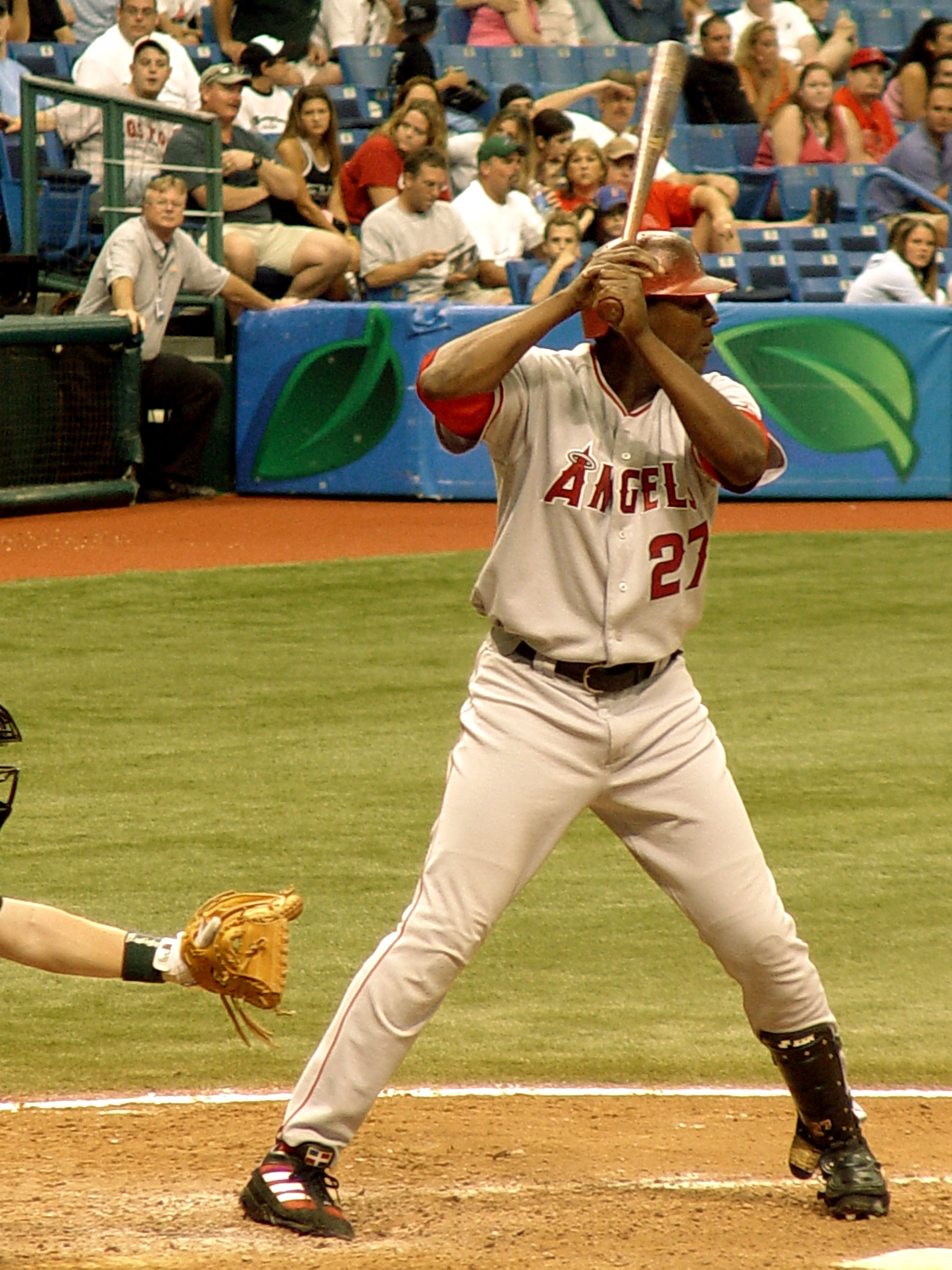
The Angels won the Western Division again in 2005, with Guerrero batting .317 with 32 home runs and 108 RBIs in 520 at-bats. On September 2, he hit his 300th career home run, becoming the 12th player to reach this milestone before the age of 30. He had a mixed postseason in 2005, batting .389 in the ALDS victory over the New York Yankees, but only .050 in the ALCS against the eventual World Series champion Chicago White Sox. He recorded his 1,000th career RBI on July 15, 2006, at home against the Tampa Bay Devil Rays.
In 2007, making his eighth All-Star appearance, Guerrero won his first career Home Run Derby, highlighted by a 503 ft (153.3 m) (503-foot) home run. He was the third Angel to win the Derby. He was selected for the All-Star Game in each of his first four seasons with the Angels (2004-2007).
3.2.4. Later Years with the Angels
Guerrero and the Angels exercised their mutual option, keeping him with the team for a sixth year in 2009. His once-stellar fielding talent declined in the late 2000s due to age and injuries, leading to his reassignment as a designated hitter at the start of the 2009 season.
In 2009, Guerrero was ranked number 37 on Sporting News' list of the 50 greatest current players in baseball, based on a poll of 100 baseball professionals. On August 10, 2009, he hit his 400th career home run off Tampa Bay Rays pitcher Russ Springer. On August 26, he recorded his 1,000th career hit as an Angel, a single off Detroit Tigers pitcher Edwin Jackson. This milestone made Guerrero only the fourth player (after Frank Robinson, Dave Winfield, and Fred McGriff) to record at least 1,000 hits in both the National League and American League.
On October 11, 2009, in Game 3 of the ALDS against the Boston Red Sox, Guerrero delivered a crucial two-run single off Jonathan Papelbon in the ninth inning, giving the Angels a 7-6 lead and securing their first-ever postseason series win against the Red Sox. The 2009 season was the first time Guerrero's batting average fell below .300 (.295), his OPS below .800 (.794), or his doubles total less than 20 (16).
3.3. Texas Rangers
Guerrero's single season with the Rangers proved to be highly successful, culminating in the team's first American League pennant.
3.3.1. Signing and Performance
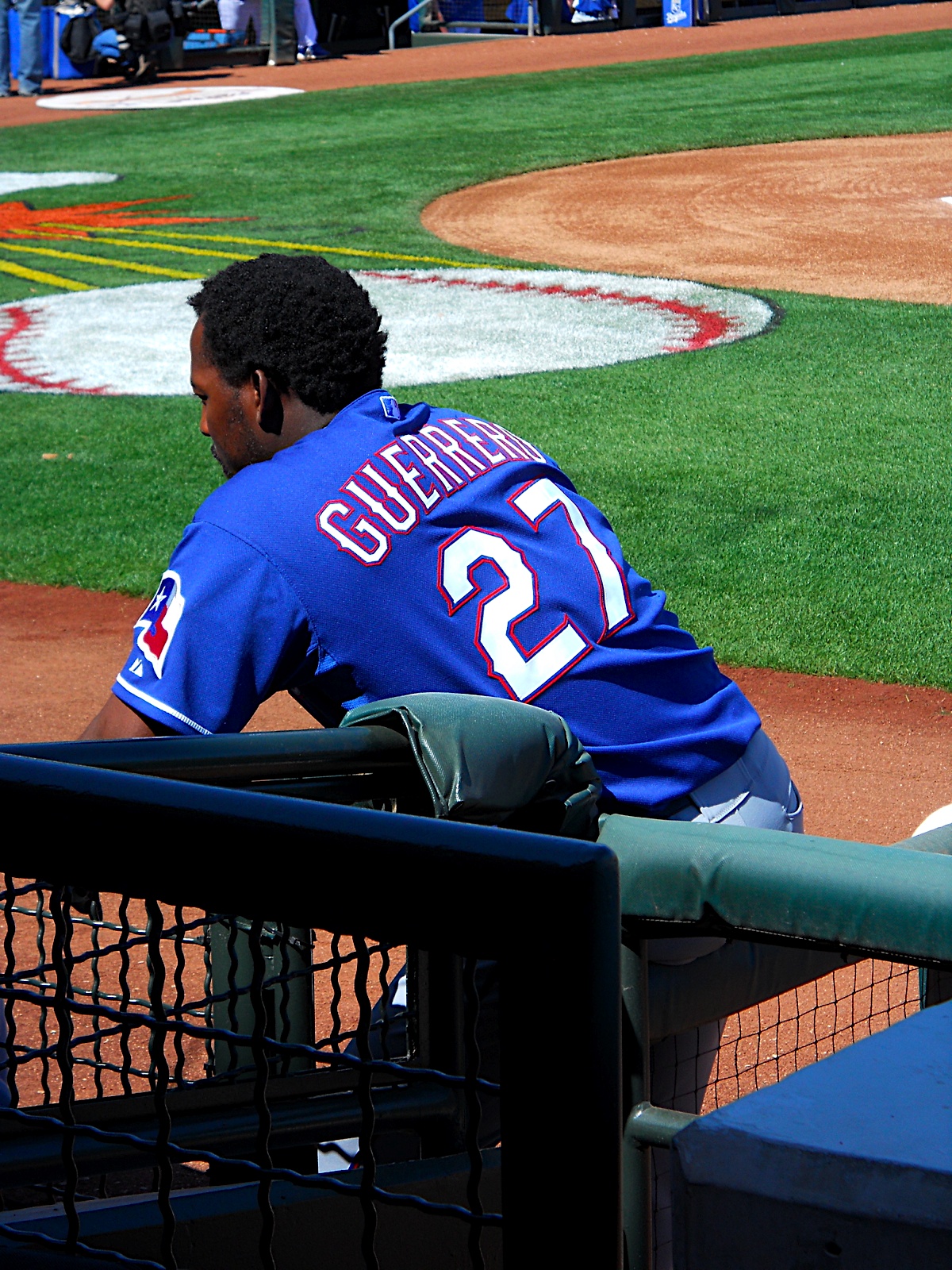
On January 11, 2010, Guerrero signed a one-year, 5.50 M USD deal with incentives and a 2011 option with the Texas Rangers. He broke up a no-hitter by Shaun Marcum in the seventh inning of the Opening Day game against the Toronto Blue Jays on April 5, 2010.
Throughout the 2010 season, Guerrero delivered several key performances. On May 6, he hit two home runs against the Kansas City Royals in a 13-12 victory. On May 13, his walk-off line drive secured a win against the Oakland Athletics in the 12th inning. On May 25, he again hit two home runs against the Royals. On June 30, against his former team, the Los Angeles Angels of Anaheim, Guerrero went 4-for-4 with two home runs and five RBIs. He finished the season appearing in 152 games with a .300 batting average, 29 home runs, and 115 RBIs.
3.3.2. Contribution to Team Success
Guerrero earned a Silver Slugger Award as a designated hitter in the regular season, contributing significantly to the Texas Rangers winning their division and, for the first time in franchise history, the American League pennant. He also won the Edgar Martínez Award and received his ninth invitation to the All-Star Game. On October 22, 2010, Guerrero drove in three runs during Game 6 of the ALCS against the New York Yankees, securing the Rangers' first AL pennant. The Rangers ultimately lost the 2010 World Series to the San Francisco Giants in five games. On November 3, the Rangers declined Guerrero's 2011 option, making him a free agent.
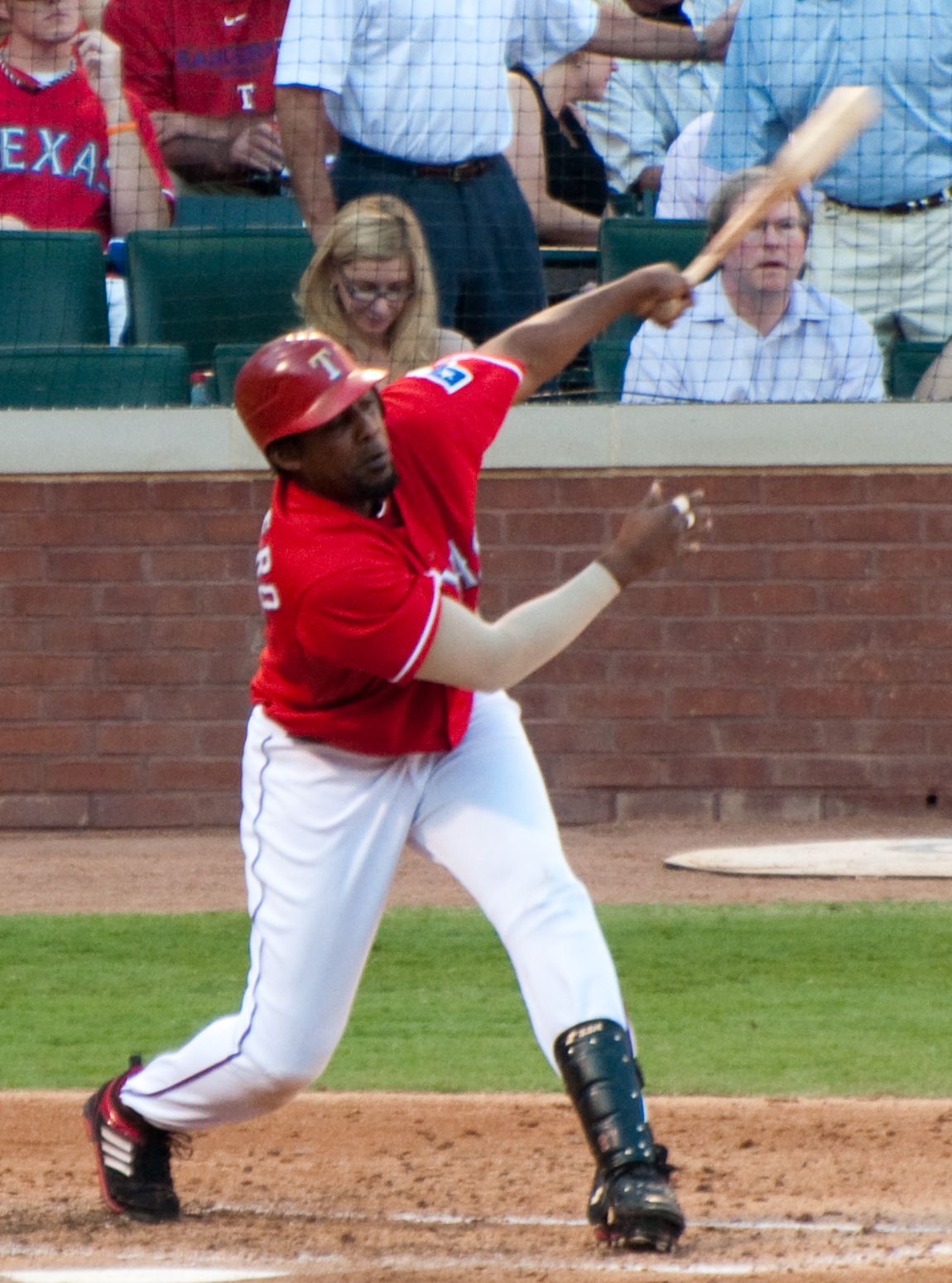
3.4. Baltimore Orioles
Guerrero spent his final MLB season with the Baltimore Orioles, achieving a significant personal milestone.
3.4.1. Signing and Record-Breaking Hit
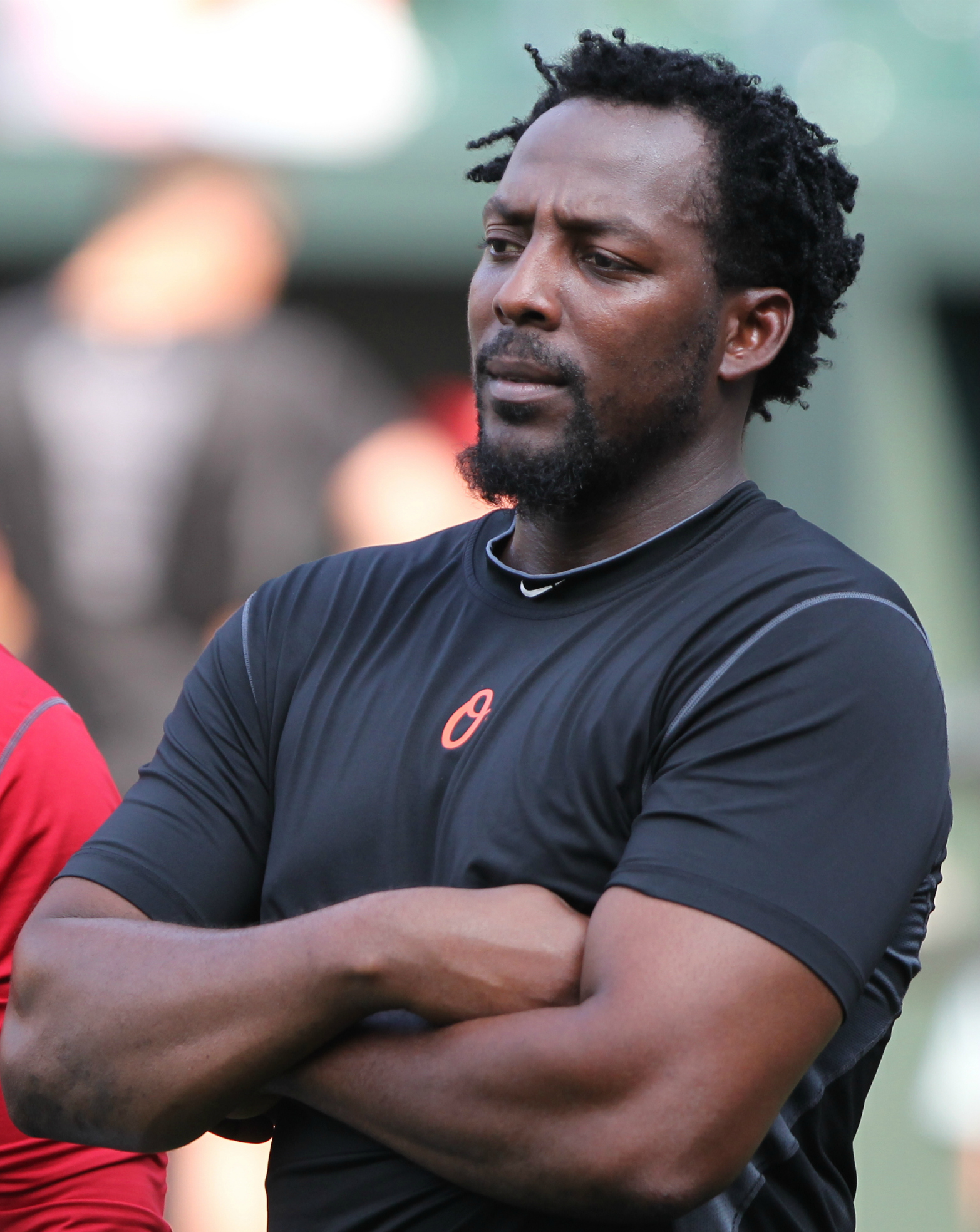
On February 18, 2011, Guerrero signed a one-year, 8.00 M USD contract with the Baltimore Orioles. On September 26, 2011, he became the all-time MLB hits leader among Dominican-born players when he singled off Josh Beckett in a 6-3 victory over the Boston Red Sox at Camden Yards. This record was later surpassed by Adrián Beltré in 2014. In 2011, Guerrero hit .290, his lowest batting average since his rookie year, along with 13 home runs, 63 RBIs, and 163 base hits.
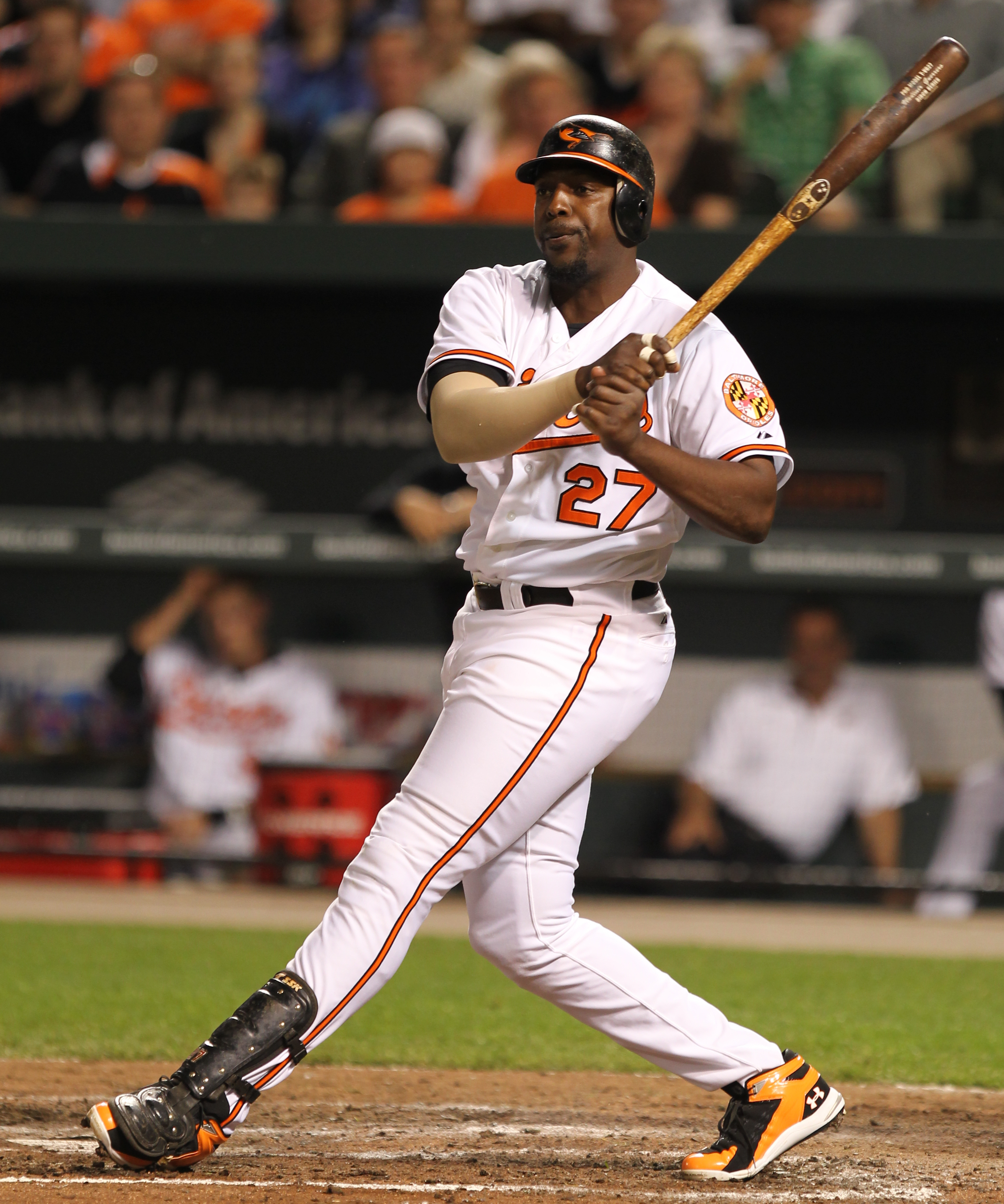
3.5. Later Career and Retirement
After his final MLB season, Guerrero continued to play briefly in minor and independent leagues before officially retiring.
3.5.1. Minor League Stints
Guerrero remained unsigned at the start of the 2012 Major League Baseball season, leading to speculation about his retirement, though he insisted he would not retire. On May 10, 2012, he signed a minor league contract with the Toronto Blue Jays. He hit a home run in his first game for the Class-A Dunedin Blue Jays on May 27, 2012. After playing four games for Dunedin, with nine hits in 20 at-bats (including four home runs), he was promoted to the Triple-A Las Vegas 51s. He played eight games with the 51s, recording 10 hits in 33 at-bats (.303 batting average), before requesting and being granted his release on June 12, 2012.
Following his stint with the Blue Jays organization, Guerrero played in the Dominican Professional Baseball League with the Estrellas Orientales of San Pedro de Macorís. On November 4, 2012, he returned to the league with Tigres del Licey, but played only eight games with a .188 batting average and no home runs. He left the team on November 20, 2012, after being informed he would only be used as a pinch hitter.
3.5.2. Independent League and Retirement
On April 4, 2013, Guerrero signed with the Long Island Ducks of the Atlantic League. However, he never appeared with the team during the 2013 season, informing them he had family issues to attend to. On September 13, 2013, he announced his retirement from professional baseball. On March 31, 2014, Guerrero signed a one-day contract with the Los Angeles Angels of Anaheim to officially retire as an Angel.
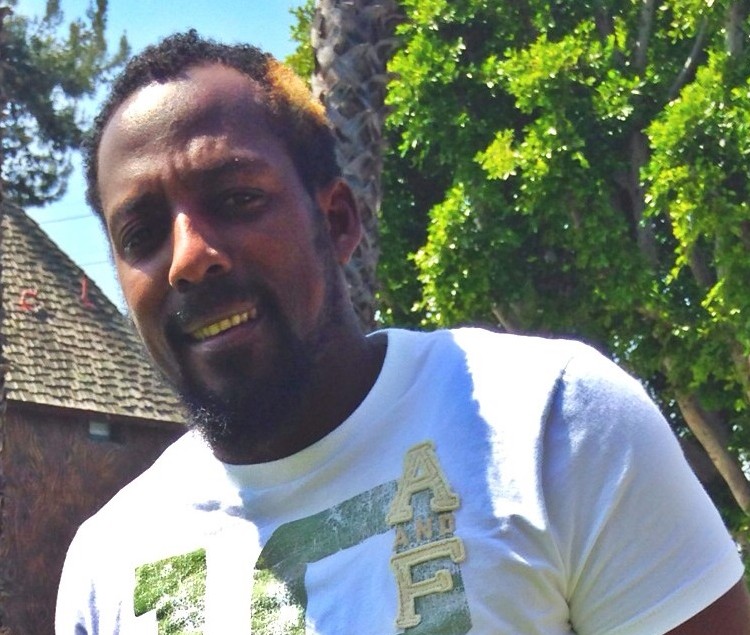
4. Batting Style and Characteristics
Vladimir Guerrero's unique and aggressive approach to hitting made him one of the most feared and distinctive hitters in baseball history.
4.1. Hitting Approach
Guerrero was renowned for his aggressive batting style and his tendency to swing at pitches thrown well outside the strike zone, a skill that earned him the moniker "bad-ball hitter." Despite this, he maintained high batting averages year after year, thanks to his superior hand-eye coordination and prodigious strength. His manager with the Angels, Mike Scioscia, famously remarked that Guerrero's strike zone extended "from his nose to his toes." In 2007, pitchers threw strikes to Guerrero only 32% of the time, compared to an average of over 50% for other hitters. In 2008, he swung at 45.5% of pitches outside the strike zone, a higher percentage than any other hitter in MLB at that time. This aggressive approach led to significantly fewer pitches taken, though it also reduced the percentage of strikes he took.
He was also known for being a "first-pitch swinger," hitting 126 home runs and putting 1,780 balls in play on the first pitch of an at-bat. Despite his free-swinging nature, he never struck out 100 times in a season. From 1997 to 2008, Guerrero consistently batted over .300. He drove in over 100 runs every season between 1998 and 2007, with the exception of 2003. He achieved a 44-game hitting streak exclusively against the Texas Rangers from 2004 to 2006, the longest such player-vs.-team streak in MLB history since 1969. During this streak, he devastated Rangers pitching, posting a career batting line of .395/.461/.661/1.122 with 25 home runs, 34 doubles, and 70 RBIs in 108 games played against them. During the 2009 postseason, Cal Ripken Jr. commented that Guerrero was "the best bad-ball hitter I've ever seen."
4.2. "Bad-Ball Hitter"
Guerrero's ability to hit pitches far outside the strike zone was legendary. One notable instance occurred on August 14, 2009, when he hit a pitch after it bounced in front of home plate. Even more unusually, his bat struck the ground before hitting the ball on that play. This unique skill allowed him to generate power and success from pitches that most hitters would ignore.
4.3. Physical Attributes and Habits
Guerrero batted without wearing batting gloves, a custom rarely seen in modern baseball. He attributed this habit to his childhood experience of helping his grandfather pull cows home barehanded in the Dominican Republic. To improve his grip on the bat, Guerrero would coat his helmet with pine tar and rub his helmet before stepping into the on-deck circle. As the season progressed, his batting helmet would become visibly covered in the substance. His powerful swing allowed him to hit the ball to all fields with authority.
5. Defense and Baserunning
While primarily known for his hitting, Guerrero also possessed notable abilities in fielding and on the base paths, though with some defensive limitations.
5.1. Arm Strength and Defensive Range
Guerrero was celebrated for his exceptionally strong throwing arm, often described as a "bazooka," capable of throwing a ball from the deepest part of right field to third base without a bounce. This arm strength allowed him to record numerous outfield assists throughout his career, including a career-high 15 assists in 1999. He also demonstrated good defensive range in the outfield, particularly in his earlier career.
5.2. Baserunning Ability
Guerrero was a surprisingly fast runner for a power hitter, possessing significant speed and stolen base capabilities. In 2001, he recorded 37 stolen bases, and in 2002, he stole a career-high 40 bases, joining the 30-30 club (39 home runs, 40 stolen bases) for the second consecutive year. He achieved 30 home runs and 30 stolen bases in both 2001 and 2002, making him the first player in MLB history to hit 30 home runs, steal 40 bases, and hit above .330 in one season (2002).
5.3. Defensive Weaknesses
Despite his strong arm, Guerrero's defensive play was often criticized for poor judgment and a tendency to commit errors. He frequently led his league in errors committed by an outfielder, including 19 in 1999, and often made errors on routine fly balls. His control on throws was sometimes erratic, with six of his nine errors in 2004 being throwing errors. These defensive shortcomings meant he never won a Gold Glove Award. As he aged and accumulated injuries, particularly to his knees, his defensive capabilities further declined, leading to his transition to primarily a designated hitter role in his later career.
6. Personal Life
Vladimir Guerrero's personal life includes his family and his commitment to his hometown in the Dominican Republic through various business ventures.
6.1. Family
Guerrero has several children, including his son, Vladimir Guerrero Jr., who was born in Montreal in 1999 during the elder Guerrero's time with the Expos. While his son became known as Vladimir Guerrero Jr., the father and son have different maternal family names: Alvino and Ramos, respectively. Vladimir Jr. signed with the Toronto Blue Jays on July 2, 2015, made his major league debut on April 26, 2019, and won the All-Star Game MVP on July 13, 2021. In 2021, Vladimir Guerrero and Vladimir Guerrero Jr. became the second father-son duo in MLB history to each have a 40-home run season, following Cecil and Prince Fielder. Another son, Pablo Guerrero, signed with the Texas Rangers as an international free agent in January 2023. A third son, Vladimir Miguel Guerrero, signed with the New York Mets on January 15, 2024. Guerrero has publicly stated that he has eight children with five different women.
6.2. Business Ventures
Guerrero has invested in his hometown in the Dominican Republic, providing job opportunities through various business ventures. These include a concrete-block factory, a propane distribution company, a supermarket, a livestock and vegetable farm, and a women's clothing store.
7. Awards and Honors
Vladimir Guerrero received numerous accolades throughout his distinguished career, culminating in his induction into the National Baseball Hall of Fame.
7.1. Major League Awards
- American League Most Valuable Player (2004)
- Edgar Martínez Award (2010)
- 9-time MLB All-Star (1999, 2000, 2001, 2002, 2004, 2005, 2006, 2007, 2010)
- 8-time Silver Slugger Award winner:
- Outfielder (1999, 2000, 2002, 2004, 2005, 2006, 2007)
- Designated Hitter (2010)
- Home Run Derby Champion (2007)
- 6-time Player of the Month:
- National League: July 1998, August 1999, April 2000, April 2002, August 2003
- American League: September 2004
- 10-time Player of the Week: July 20-26, 1998; August 9-15, 1999; September 27-October 3, 1999; April 3-9, 2000; June 25-July 1, 2001; April 21-28, 2002; August 25-31, 2003; September 27-October 3, 2004; August 8-14, 2005; April 2-8, 2007.
- Baseball America First-Team Major League All-Star OF (2000, 2004)
- Baseball America Second-Team Major League All-Star OF (1998, 1999, 2005)
- The Sporting News American League Comeback Player of the Year Award (2010)
7.2. Minor League Honors
- 2-time Montreal Expos Minor League Player of the Year (1995, 1996)
- South Atlantic League All-Star OF (1995)
- Eastern League MVP (1996)
- Double-A Player of the Year (1996)
- Baseball America 1st team Minor League All-Star OF (1996)
- Double-A All-Star OF (1996)
- Eastern League Rookie of the Year (1996)
- The Sporting News Minor League Player of the Year Award (1996)
7.3. Hall of Fame Induction
- Inducted into the Canadian Baseball Hall of Fame (2017)
- Inducted into the Baseball Hall of Fame (2018)
- Inducted into the Angels Hall of Fame (2017)
8. Career Statistics
Vladimir Guerrero's 16-season MLB career was marked by consistent offensive excellence.
8.1. Regular Season Statistics
In 2,147 games over 16 seasons, Guerrero posted a .318 batting average (2,590 for 8,155) with 1,328 runs, 477 doubles, 46 triples, 449 home runs, 1,496 RBI, 181 stolen bases, 737 bases on balls, a .379 on-base percentage, and a .553 slugging percentage. Defensively, he finished his career with a .963 fielding percentage. He reached 1,000 career hits in 2002, 1,000 RBIs in 2006, 1,000 runs in 2007, 2,000 hits in 2008, 400 home runs in 2009, and 400 doubles in 2008.
| Year | Team | G | PA | AB | R | H | 2B | 3B | HR | TB | RBI | SB | CS | SH | SF | BB | IBB | HBP | SO | GDP | AVG | OBP | SLG | OPS |
|---|---|---|---|---|---|---|---|---|---|---|---|---|---|---|---|---|---|---|---|---|---|---|---|---|
| 1996 | MON | 9 | 27 | 27 | 2 | 5 | 0 | 0 | 1 | 8 | 1 | 0 | 0 | 0 | 0 | 0 | 0 | 0 | 3 | 1 | .185 | .185 | .296 | .481 |
| 1997 | MON | 90 | 354 | 325 | 44 | 98 | 22 | 2 | 11 | 157 | 40 | 3 | 4 | 0 | 3 | 19 | 2 | 7 | 39 | 11 | .302 | .350 | .483 | .833 |
| 1998 | MON | 159 | 677 | 623 | 108 | 202 | 37 | 7 | 38 | 367 | 109 | 11 | 9 | 0 | 5 | 42 | 13 | 7 | 95 | 15 | .324 | .371 | .589 | .960 |
| 1999 | MON | 160 | 674 | 610 | 102 | 193 | 37 | 5 | 42 | 366 | 131 | 14 | 7 | 0 | 2 | 55 | 14 | 7 | 62 | 18 | .316 | .378 | .600 | .978 |
| 2000 | MON | 154 | 641 | 571 | 101 | 197 | 28 | 11 | 44 | 379 | 123 | 9 | 10 | 0 | 4 | 58 | 23 | 8 | 74 | 15 | .345 | .410 | .664 | 1.074 |
| 2001 | MON | 159 | 671 | 599 | 107 | 184 | 45 | 4 | 34 | 339 | 108 | 37 | 16 | 0 | 3 | 60 | 24 | 9 | 88 | 24 | .307 | .377 | .566 | .943 |
| 2002 | MON | 161 | 709 | 614 | 106 | 206 | 37 | 2 | 39 | 364 | 111 | 40 | 20 | 0 | 5 | 84 | 32 | 6 | 70 | 20 | .336 | .417 | .593 | 1.010 |
| 2003 | MON | 112 | 467 | 394 | 71 | 130 | 20 | 3 | 25 | 231 | 79 | 9 | 5 | 0 | 4 | 63 | 22 | 6 | 53 | 18 | .330 | .426 | .586 | 1.012 |
| 2004 | ANA/LAA | 156 | 680 | 612 | 124 | 206 | 39 | 2 | 39 | 366 | 126 | 15 | 3 | 0 | 8 | 52 | 14 | 8 | 74 | 19 | .337 | .391 | .598 | .989 |
| 2005 | ANA/LAA | 141 | 594 | 520 | 95 | 165 | 29 | 2 | 32 | 294 | 108 | 13 | 1 | 0 | 5 | 61 | 26 | 8 | 48 | 17 | .317 | .394 | .565 | .959 |
| 2006 | ANA/LAA | 156 | 665 | 607 | 92 | 200 | 34 | 1 | 33 | 335 | 116 | 15 | 5 | 0 | 4 | 50 | 25 | 4 | 68 | 16 | .329 | .382 | .552 | .934 |
| 2007 | ANA/LAA | 150 | 660 | 574 | 89 | 186 | 45 | 1 | 27 | 314 | 125 | 2 | 3 | 0 | 6 | 71 | 28 | 9 | 62 | 19 | .324 | .403 | .547 | .950 |
| 2008 | ANA/LAA | 143 | 600 | 541 | 85 | 164 | 31 | 3 | 27 | 282 | 91 | 5 | 3 | 0 | 4 | 51 | 16 | 4 | 77 | 27 | .303 | .365 | .521 | .886 |
| 2009 | ANA/LAA | 100 | 407 | 383 | 59 | 113 | 16 | 1 | 15 | 176 | 50 | 2 | 1 | 0 | 1 | 19 | 3 | 4 | 56 | 16 | .295 | .334 | .460 | .794 |
| 2010 | TEX | 152 | 643 | 593 | 83 | 178 | 27 | 1 | 29 | 294 | 115 | 4 | 5 | 0 | 6 | 35 | 5 | 9 | 60 | 19 | .300 | .345 | .496 | .841 |
| 2011 | BAL | 145 | 590 | 562 | 60 | 163 | 30 | 1 | 13 | 234 | 63 | 2 | 2 | 0 | 4 | 17 | 3 | 7 | 56 | 23 | .290 | .317 | .416 | .733 |
| MLB Totals: 16 seasons | 2147 | 9059 | 8155 | 1328 | 2590 | 477 | 46 | 449 | 4506 | 1496 | 181 | 94 | 0 | 64 | 737 | 250 | 103 | 985 | 277 | .318 | .379 | .553 | .932 | |
8.2. Postseason Statistics
In 44 postseason games, Guerrero hit .263 (45-for-171) with 17 runs, seven doubles, two home runs, 20 RBIs, two stolen bases, and 14 walks.
9. Legacy and Hall of Fame
Vladimir Guerrero's legacy is defined by his unique hitting style, consistent offensive production, and his historic induction into the National Baseball Hall of Fame.
9.1. Hall of Fame Enshrinement
Guerrero became eligible for induction into the Baseball Hall of Fame in 2017 and was inducted in 2018, receiving 92.9% of the vote. He was enshrined alongside Chipper Jones, Jim Thome, and Trevor Hoffman. Notably, Guerrero is the first member of the Hall of Fame to be depicted with an Angels cap on his plaque, despite having played more games (1,004 vs. 846) and seasons (8 vs. 6) as a Montreal Expo. He was also inducted into the Canadian Baseball Hall of Fame in 2017 and the Angels Hall of Fame in the same year.
9.2. Influence on the Game
Guerrero is widely regarded as one of the greatest hitters of his era, known for his aggressive approach and his ability to hit pitches far outside the strike zone. His unique style, combined with his powerful bat and strong arm, made him a captivating player to watch and a formidable opponent. He left a lasting impact on the game through his consistent offensive production, including eight seasons with over 30 home runs and ten seasons with over 100 RBIs. His career .318 batting average is the highest among players who primarily played in the 21st century.
9.3. Comparison with Son
A unique aspect of Vladimir Guerrero's legacy is the success of his son, Vladimir Guerrero Jr.. In 2021, they became only the second father-son duo in MLB history to each achieve a 40-home run season in their careers, a testament to the family's exceptional baseball talent. This shared achievement further cements Vladimir Guerrero's place in baseball history.